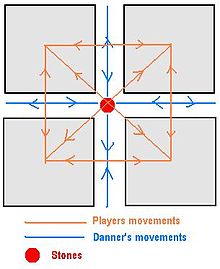- Nalugu Rallu Aata
-
Nalugu Rallu Aata is a very ancient traditional outdoor 4-player game played by the children of the past generation, until late 1960s and '80s in many rural districts of Andhra Pradesh State. The origin and the birth of this game is unknown. Today this game has completely vanished due to urbanization and invasion of western games.
Four independent boxes are drawn on plane ground as shown in the figure. The blue line indicates the path along which the danner moves and the orange lines indicate the path along which the players move. A danner is decided after the chain cut.
Objective of the game
Four players stand in their squares and four stones one above the other are placed at the center. The objective of each player is to have a stone with out being captured by the danner. The objective of the danner is to capture the players who move in their way.
Strategy of the game
When the game starts, the danner keeps moving along his path to capture the players who try to pick up the stones. The danner is not supposed to enter into the boxes. One of the players take initiative to pick up all the stones and tries to move into any of the boxes one by one and distributes the stones to the other players. However it is not necessary that only one player should take initiative in picking up all the stones, but every player can pick up any number of stones for distribution. When each player picks up at least one stone by default, there is no need of distribution.
When all the players get their stones, they would ask the danner to choose either “Gumpu” (Group) or “Chuttu” (circling). When the danner chooses Gumpu, and selects a particular box, then all other players carefully gather in the selected box, with the stones in their hands. For the choice of Chuttu, each player will have to make 6 rounds and finally reach his/her native box. A player, while shifting to other boxes, is declared to be out when he/she is touched by the danner. The game continues as long as one of the players is out.
Categories:
Wikimedia Foundation. 2010.

